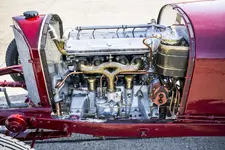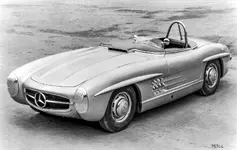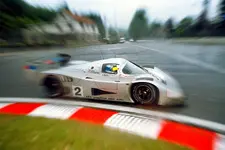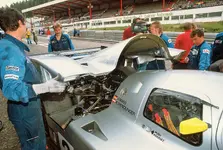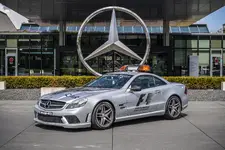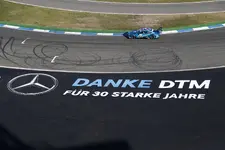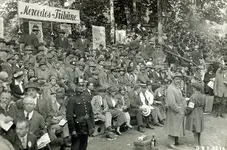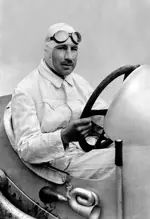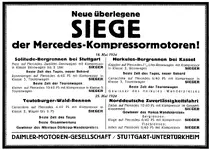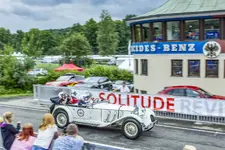#mercedes #mercedesbenz #mercedesclassics #classiccar #targafiorio #c11 #mercedesbenzclassic
- One of the stars taking part is the restored Mercedes 2-litre Targa Florio car from 1924
- Otto Merz wins the Großer Solitude Bergpreis with Mercedes 100 years ago
- Racing drivers Karl Wendlinger and Bernd Schneider compete for Mercedes-Benz
- Engine starts of the Mercedes-Benz C 11 Group C racing car with a distinctive sound
- 22 and 23 June 2024: Around 400 racing and sports cars in action at the legendary circuit
One of the sensations is the Mercedes 2-litre Targa Florio racing car from 1924, which has been roadworthy again since April 2024. In mid-May 2024, Mercedes-AMG Formula One racing driver George Russell was the first to drive this restored racing legend in a motorsport environment, on the Emilia Romagna Grand Prix circuit in Italy. Prior to this, the Mercedes-Benz Classic Center subjected the 100 year-old original racing car to a comprehensive factory restoration. Christian Werner took first place in the Targa Florio in Sicily with this racing car model on 27 April 1924. A few weeks later, Werner presented the winning car from Sicily with a lap of honour at the 1924 Solitude Hill Climb Grand Prix on 18 May 1924.
In this race, Otto Merz won the last hill climb at the Solitude in the racing car class with a supercharged 2-litre racing car identical to that used in the Indianapolis 500 in May 1923. He achieved the best time of the day of 3:28.8 minutes and set a new track record. In the following year, Merz repeated his success at the premiere of “Rund um die Solitude” in a Mercedes 2-litre Targa Florio racing car and once again set the track record. Merz, born in 1889, celebrated successes for Mercedes and Mercedes-Benz as a works racing driver, especially after the First World War. One of his triumphs was the victory on 17 July 1927 in the German Grand Prix for sports cars at the Nürburgring, which had opened a few weeks earlier, with a Mercedes-Benz Type S (W 06). In 1933, Merz had a fatal accident during training for the International AVUS Race in Berlin.
Brand ambassador Karl Wendlinger will drive the Targa Florio racing car at the 2024 Solitude Revival. In 1990 and 1991, the Austrian contested the World Sports Car Championship in the Group C racing cars fielded by the Swiss Sauber team. The Mercedes-Benz C 11 won this championship in 1990. One of these racing sports cars will be on display at the Solitude. Its approximately 537 kW (730 hp) eight-cylinder engine with two turbochargers is regularly started there.
Mercedes-Benz has provided the official safety car in Formula One since 1996. At the 2024 Solitude Revival, an original Mercedes-Benz SL 63 AMG Official F1™ Safety Car from the 2008 season will be the pace car for the races, which will be well-attended with around 400 racing and sports cars of various classes. Also in the cockpit will be one of the most successful touring car drivers of all time, five-time DTM champion Bernd Schneider.
Mercedes-Benz Classic is bringing more vehicles to the Solitude Revival. These include a 300 SLS touring sports car (W 198) for a joint photo point with Porsche and a 300 SEL 6.3 (W 109) set up as a sporty track tool. Exciting activities for the public in the display area include a driving simulator and wheel changes on a Mercedes-AMG C 63 DTM racing touring car from the C 205 series.
Hardly any changes to the Solitude course
Alongside the North Loop at Nürburgring, the Solitude circuit near Stuttgart is one of the most challenging race tracks in Europe with its uphill and downhill sections, a high-speed section and the multiple bends on the final kilometres before the finishing line. The circuit, which has only been modified in a few places, is integrated into the public road network. The track is only closed for events such as the Solitude Revival, which has been held regularly since 2008.
This route has been in use since 1935. Previously the Solitude races were held on hill routes until 1924, and on a long circuit from 1925 onwards. At that time, the impressive Solitude Palace (built between 1763 and 1769) on a mountain ridge was also included. In the 1930s, and again from the 1950s onwards, up to 400,000 spectators would visit the current circuit at weekends. This was to follow motorcycle and racing car events right up to Formula One. Even though the “Solitude” never counted towards the Formula One World Championship, the outstanding racing drivers taking part included champions and Grand Prix winners such as Jim Clark, John Surtees, Dan Gurney, Jochen Rindt, Jack Brabham, Wolfgang Graf Berghe von Trips and Mercedes-Benz Silver Arrow racing driver and brand ambassador Hans Herrmann.
The Mercedes-Benz Classic vehicles at the Solitude Revival on 22 and 23 June 2024
Mercedes 2-litre Targa Florio racing car, 1924
Daimler-Motoren-Gesellschaft (DMG) developed this then ultra-modern racing car in 1924 for the most important racing event of the year, the Targa Florio in Sicily. The vehicle bore the signature of Paul Daimler but was developed to racing maturity by his successor Ferdinand Porsche. The racing car is characterised by lightweight construction and its M 7294 supercharged engine with the high-revving concept popular at the time. The 2-litre four-cylinder engine develops 50 kW (67.5 hp), with the supercharger increasing output to 93 kW (126 hp) – almost twice as much. Four-valve technology, two overhead camshafts and cylinders and cylinder heads welded together to form blind cylinders are further characteristics of the engine. The design of the racing engine also incorporates DMG’s experience from the development of high-revving concepts with up to 4,500 rpm. This is made possible by roller bearings for the crankshaft. Porsche also used exhaust valves with mercury-filled stems for the first time in a racing engine so as to significantly improve heat dissipation. Among other features, the aluminium body with steel struts ensures a low vehicle weight. The fully-fuelled two-seater racing car weighed just 1,015 kilograms when ready to drive. The racing car also scored points with its compact design, especially on winding circuits such as the Targa Florio or the Solitude. Mercedes entered three red-painted racing cars in the legendary Sicilian road race in 1924. Christian Werner was the first non-Italian driver to secure overall victory in the Targa and the Coppa Florio. Two other Mercedes 2-litre racing cars finished in 11th (Christian Lautenschlager) and 16th (Alfred Neubauer) place in the Targa Florio, and 9th and 13th respectively in the Coppa Florio. From 2022 onwards, Mercedes-Benz Classic subjected one of the original racing cars to a comprehensive works restoration. Right on time for the 2024 anniversary, the 100-year-old racing car was put back into operation to delight the public at various events. One of the drivers is current Mercedes-AMG Formula One driver George Russell.
Technical data – Mercedes 2-litre Targa Florio racing car
Period of use: 1924 to 1926
Cylinders: 4/in-line
Displacement: 1,989 cc
Output: 50 kW (67.5 hp), with supercharger 93 kW (126 hp)
Maximum speed: 120 km/h
Mercedes-Benz 300 SLS Touring Sports Car (W 198), 1957
The Mercedes-Benz 300 SLS (“Super Light Sport”) was a special racing version of the 300 SL Roadster (W 198). Two examples of the touring sports car were built in 1957 for the American Sports Car Championship, as homologation of the production version of the new model for the “Standard Production” category in the 1957 season was not possible. So as not to be left without a chance in the only alternative possible, Racing Category D, a standard roadster was optimised to become the 300 SLS, weighing just 970 kilograms and with an output of 173 kW (235 hp). That was 360 kilograms less and 15 kW (20 hp) more than the 300 SL Roadster. With the 300 SLS, Paul O’Shea, supported by the factory, won the 1957 American Sports Car Championship in Category D with a clear lead over the competition. He had already won the title with the 300 SL “Gullwing” Coupé in 1955 and 1956. Mercedes-Benz Classic is bringing an authentic replica of the original 300 SLS to the Solitude Revival.
Technical data – Mercedes-Benz 300 SLS (W 198)
Period of use: 1957
Cylinders: 6/in-line
Displacement: 2,996 cc
Output: 173 kW (235 hp) at 5,900 rpm
Maximum speed: 260 km/h
Mercedes-Benz 300 SEL 6.3 Track Tool (W 109)
In March 1968, Mercedes-Benz presented a luxury saloon with the performance potential of top-class sports cars of the time: the 300 SEL 6.3 (W 109) with the V8 engine and automatic transmission of the Mercedes-Benz 600 (W 100) prestige limousine caused a sensation. A total of 6,526 units of the top-of-the-range model in the W 108 and W 109 series, which was launched in 1965, were produced up to 1972. Mercedes-Benz Motorsport based this track tool on a 300 SEL 6.3 in order to use it for taxi rides in the DTM, and to demonstrate the sporting capabilities of the V8 saloon. As part of the sporty modification, the 184 kW (250 hp) vehicle was fitted with a Getrag six-speed manual transmission with Sachs racing clutch, a stainless steel exhaust system, KW racing suspension, a high-capacity oil circuit and a large radiator. There are also two bucket seats in the front, a rollover cage and a racing safety tank as well as a fire-extinguishing system. The TRACK TOOL is shod with three-piece BBS wheels and features ATE eight-piston front brakes with slotted discs. The pedals include an adjustable braking system (“balance beam”) as a typical racing feature.
Technical data – Mercedes-Benz 300 SEL 6.3 (W 109), standard version
Production period: 1968 to 1972
Cylinders: V8
Displacement: 6,332 cc
Output: 184 kW (250 hp)
Maximum speed: 220 km/h
Mercedes-Benz C 11 Group C racing sports car, 1990
After winning the team and drivers’ title in the 1989 Group C World Championship with the C 9, Sauber-Mercedes developed the C 11 for 1990. The focus was on a new chassis with a monocoque made of carbon-Kevlar material. In addition, the four-valve V8 engine M 119 HL was further improved in the areas of valve control, injection and engine electronics, with output increasing to 537 kW (730 hp). The wheelbase also slightly increased by 70 millimetres, to 2,770 millimetres. The completely redesigned chassis offered twice the torsional rigidity of the previous construction made of bonded and riveted aluminium, and with only a slight increase in weight, which benefited the handling of the silver-coloured C 11. The new carbon-fibre chassis brought an optimised underbody design, with a positive effect on the car’s downforce values. In 1990, the C 11s won seven of the eight world championship races, once again securing the team victory for the Sauber-Mercedes team in the sports car world championship. Jean-Louis Schlesser, Mauro Baldi and Jochen Mass won the top three places in the driver rankings.
Technical data – Mercedes-Benz C 11 Group C racing sports car
Period of use: 1990 to 1991
Cylinders: V8
Displacement: 4,973 cc
Output: 537 kW (730 hp)
Maximum speed: around 400 km/h
Mercedes-Benz SL 63 AMG Official F1™ Safety Car (R 230), 2008
In spring 2008, Mercedes-Benz presented the extensively updated SL Roadster of the R 230 model series. For visual effect, the updated sports car featured a wide and very dominant radiator grille with a horizontal louvre. This design feature was reminiscent of the front design of earlier Mercedes-Benz SL models. The powerdomes on the bonnet and the gill-like air outlets in the front wings also harked back to the origins of the SL family. Namely to the 300 SL Coupé (W 198) of 1954. The new top-of-the-range V8 model in the updated R 230 series was the 386 kW (525 hp) SL 63 AMG with the 6.2-litre M 156 engine. This was used as the Official F1™ Safety Car in the 2008 and 2009 Formula One seasons. Its impressive driving dynamics were a basic prerequisite for the demands of the premier class in motorsport. The AMG engine made for acceleration from zero to 100 km/h in 4.4 seconds, and the sports exhaust system not only allowed the engine to breathe more freely, but also made it sound more sporty.
Technical data – Mercedes-Benz SL 63 AMG (R 230), standard version
Production period: 2008 to 2011
Cylinders: V8
Displacement: 6,208 cc
Output: 386 kW (525 hp)
Maximum speed: 250 km/h (electronically limited)
Mercedes-AMG C 63 DTM (C 205), 2018
The Mercedes-AMG C 63 DTM racing touring car with the silhouette of the Mercedes-Benz C-Class Coupé of the C 205 model series competed in the German Touring Car Masters (DTM) from 2016 to 2018. With a car like this, Mercedes-AMG racing driver Gary Paffett brought 30 years of Mercedes-Benz DTM involvement to a perfect close: for the second time after 2005, Paffett won the DTM drivers’ championship for Mercedes-AMG Motorsport in its 436th and final DTM race. The team’s track record in 30 years of the DTM: seven manufacturers’ titles, 11 drivers’ titles, 14 victories in the team rating, 190 wins and 140 pole positions. At the height of its success, Mercedes-AMG withdrew from the DTM at the end of the 2018 season. The brand returned to the DTM with the introduction of the GT3 regulations in the 2021 season.
Technical data – Mercedes-AMG C 63 DTM (C 205)
Period of use: 2016 to 2018
Cylinders: V8
Displacement: 4,000 cc
Output: 386 kW (525 hp) at 7,500 rpm
Maximum speed: around 280 km/h
Continue reading...
